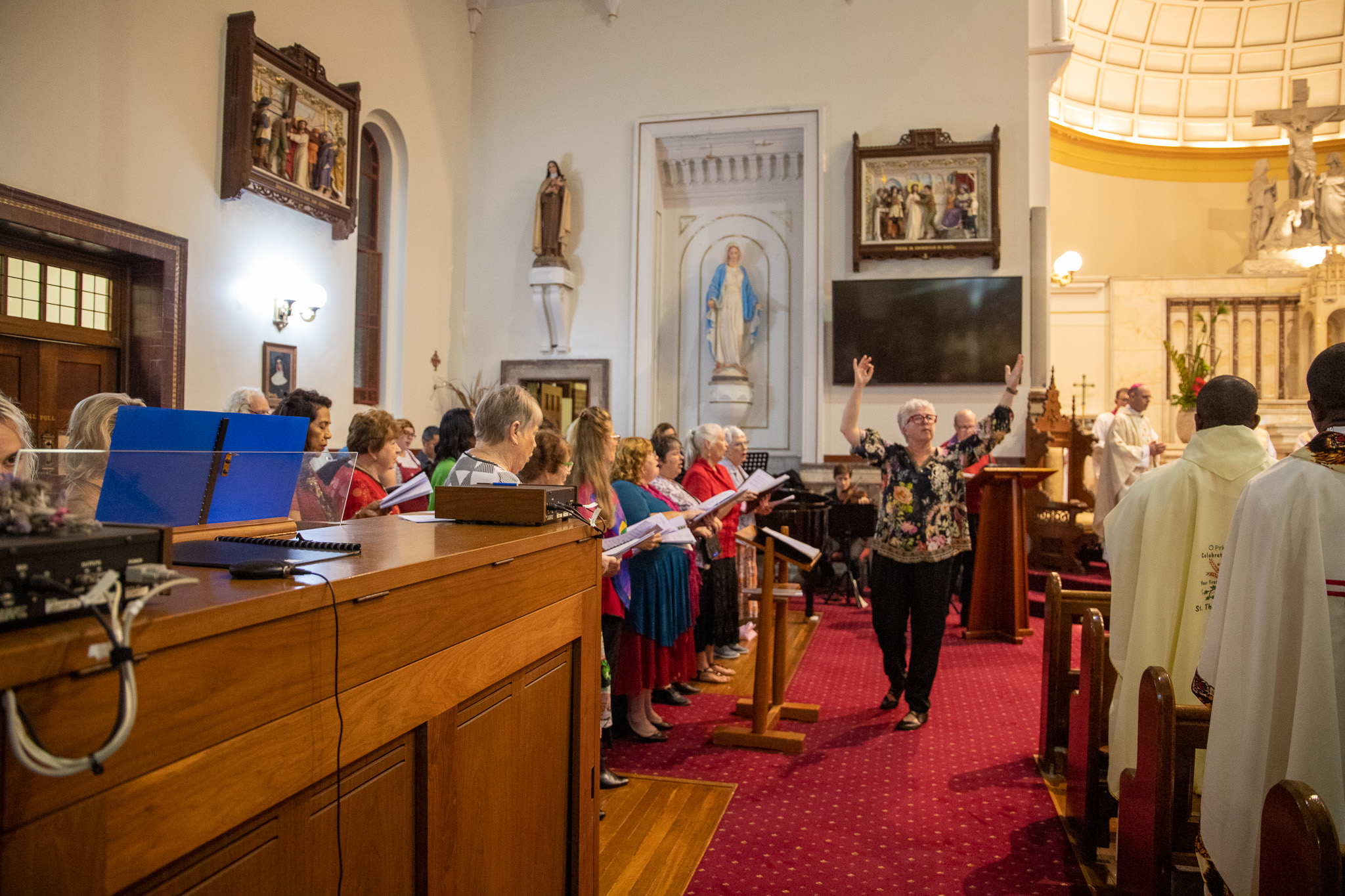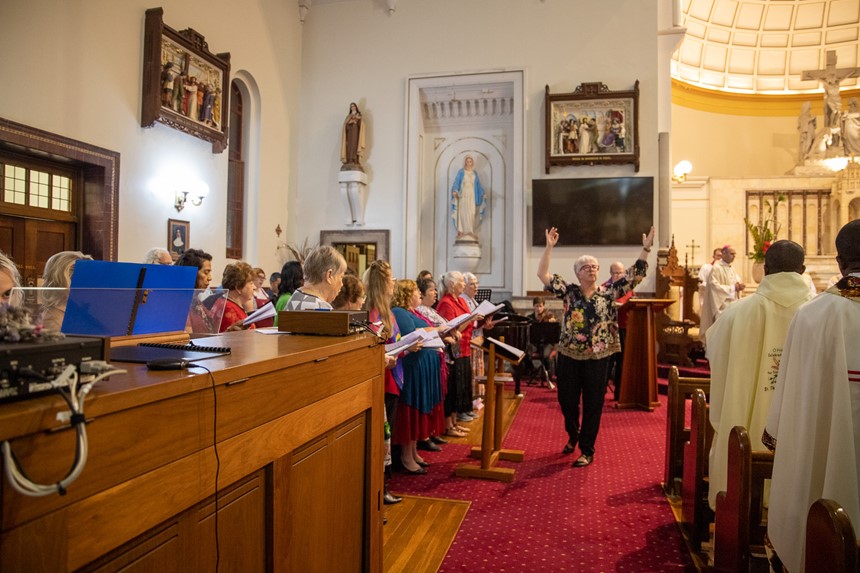Admittedly with only one or two exceptions, I quite agree that the musical aspect of the ceremony was of high quality, with newly composed pieces alongside music that have been part of previous coronations and, without which, a coronation would hardly be a coronation.
The combined choirs of Westminster Abbey, along with various soloists, were in fine voice, particularly for the two compositions that are intrinsic to a British coronation: Sir Hubert Parry’s I was Glad, based on Psalm 122, during the procession of the King and Queen, and G.F. Handel’s Zadok the Priest, during the anointing of the King.
However, it is interesting to note that the first hymn, something that all those inside the Abbey could join in singing, came more than halfway through the service. Until that point, only the ‘professionals’ had sung – worthily and well, admittedly, but to the exclusion of everyone else.
So that raises a couple of questions for me, questions that are not just about the recent Coronation Service: What is the role of music during liturgy? Does what we sing, and how we sing, matter?
Music is intrinsic to community praise and worship
As we saw during the Coronation Service, music can add beauty to any liturgical occasion. Yet, it must be remembered that this adornment is not the primary purpose for using music during the liturgy. It is not something that is separate from the liturgical action the community has gathered to celebrate; music is intrinsic to what the community does when it gathers to give praise and worship to God.
It will surprise you not that the Church has things to say about the place of music within the Church’s liturgical life. At a universal level, the Constitution on the Sacred Liturgy [CSL] (1963), the Instruction Musicam Sacram [MS] (1967), and the General Instruction of the Roman Missal [GIRM] (2011) all have much to say about the significance of music in the Church’s liturgical life. Bishops’ Conferences around the world, particularly the US Bishops, have produced statements on the nature and role of music within the liturgy. And these documents, both universal and from other Bishops’ Conferences, have influenced the work of the National Liturgical Music Council here in Australia.
“Great importance should therefore be attached to the use of singing in the celebration of Mass, with due consideration for the culture of peoples and abilities of each liturgical assembly” (GIRM, n.40). Singing during the liturgy provides a “more noble form” to liturgical worship, allowing prayer to be expressed in “more attractive ways” (MS, n.5). Above all, however, the “active participation of the people” is to be encouraged when discerning what and how we sing during the liturgy (MS, n.5; see also CSL, n.14).
Choosing what should be sung at any particular liturgical celebration must adhere to the principle of “progressive solemnity”, best expressed in Musicam Sacram thus:
Between the solemn, fuller form of liturgical celebration, in which everything that demands singing is in fact sung, and the simplest form, in which singing is not used, there can be various degrees according to the greater or lesser place allotted to singing. However, in selecting the parts which are to be sung, one should start with those that are by their nature of greater importance, and especially those which are to be sung by the priest or by the ministers, with the people replying, or those which are to be sung by the priest and people together. The other parts may be gradually added according as they are proper to the people alone or to the choir alone. (n.7)
This understanding of which elements of the liturgy have priority for singing is repeated in paragraph 41 of the General Instruction to the Roman Missal.
We sing the Mass


These and other excerpts from the Church’s official teaching on liturgy and liturgical music make one thing clear: We do not, therefore, simply sing at Mass; we sing the Mass. And what is true for the celebration of Mass, the highpoint of the Church’s liturgical life, is also true of other liturgical celebrations. Priority of singing is thus not on which hymns we might sing, but which of the acclamations (e.g., the Gospel Acclamation, Sanctus, Memorial Acclamation, Great Amen) or proclamations (the Gloria, the Responsorial Psalm, the Antiphons) we ought to sing on a particular occasion. Only once that decision is made do we move on to determine what hymns might be used in place of one of the acclamations or proclamations.
This understanding of ‘singing the Mass’ means that what we sing, and how we sing, needs careful preparation and discernment. It is necessary for those responsible for music in the liturgy to take the time to select music according to well-established principles when doing so. The four principles outlined below are all designed to assist in answering one primary question: “Is this particular piece of music appropriate for its use in this particular liturgy?”
Four principles of selecting music for liturgy
- The first principle concerns the textual or theological appropriateness of the piece of music. It seeks to evaluate whether the text of the piece of music is drawn from Scripture or is otherwise theologically robust for use within Catholic liturgy. Is the composition thematically and linguistically coherent? Is there a poetic power to the text? It needs to be recognised that some music, particularly most modern compositions that come from a “praise and worship” genre, may not convey a theological understanding that is coherent with the Church’s belief. Similarly, music from more ancient sources sometimes no longer best expresses the Church’s belief.
- The second principle is often overlooked. Music used in a liturgical celebration must meet the liturgical needs of the celebration. Does the music ‘fit’ the ritual action that it is being used for? Or does it present a dissonance between what is being sung and the action being performed? One of the clearest examples of this that is often encountered is the use of hymns during the Communion Procession (when we come forward to receive Communion) that are better suited for Adoration and Benediction. There is a potential for a clear rupture here: we are not worshipping the Eucharist; we are coming forward to receive Communion. What we sing, therefore, should match what we are doing. Similarly, when the Gifts of Bread and Wine are being brought forward from the community, what we sing should reflect this action; it may not be the time for a Marian Hymn or a Hymn to St Joseph. What we sing must match our actions.
- The third principle, that of pastoral appropriateness, is focused on one simple question: does this piece of music assist this particular assembly to fully, consciously, and actively enter into the praise and worship of God that is at the heart of any liturgical celebration? The answer, of course, will vary from place to place, depending on the demographics of a community, and what musical resources they might have access to. This principle is of particular importance when introducing compositions to a community, a process that requires care, patience, and genuine care for the community.
- The fourth and last principle rests on the musical appropriateness of the music under consideration. Is it appropriate for use within the liturgy? Is it technically, aesthetically, and expressively worthy of liturgical use? Is it too secular so as being unable to bear the burden of being used for the praise and worship of God? This assessment often requires musical expertise, but it is an assessment that still needs to be made.
The role of music during liturgy
Each particular liturgical celebration is composed of many variable verbal and nonverbal elements: proper prayers, scriptural readings, the liturgical season, the time of day, processional movement, sacred objects and actions, the socio-economic context in which the particular community is set, or even particular events impacting the life of the Christian faithful. Every effort should be made to lend such disparate elements a certain unity by the skilful and sensitive selection and preparation of texts, music, homily, movement, vesture, colour, environment, and sacred objects and actions. This kind of ritual art requires that those who prepare the liturgy approach it with artistic sensitivity and pastoral perspective.
Music does what words alone cannot do. It is capable of expressing a dimension of meaning and feeling that words alone cannot convey. While this dimension of an individual musical composition is often difficult to describe, its affective power should be carefully considered along with its textual component.
The role of music is to serve the needs of the liturgy and not to dominate it, seek to entertain, or draw attention to itself or the musicians. However, there are instances when the praise and adoration of God leads to music taking on a far greater dimension. At other times, simplicity is the most appropriate response. The primary role of music in the liturgy is to help the members of the gathered assembly to join themselves with the action of Christ and to give voice to the gift of faith.
Follow mnnews.today on Facebook.